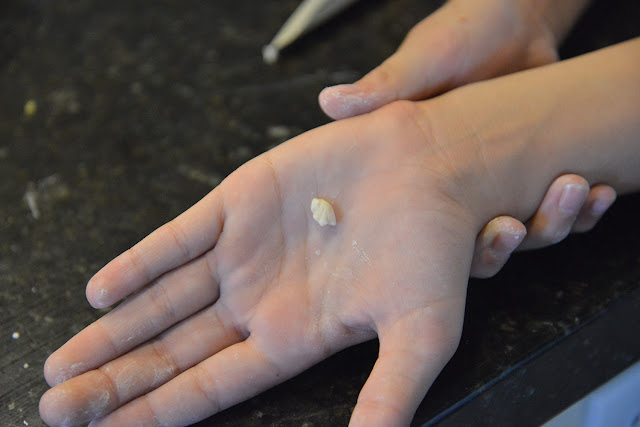One night we decided to try making gyoza, which are the Japanese version of potstickers. We LOVE to eat potstickers, so we were pretty sure we'd like making them too.
I adapted this pork gyoza recipe, but now that I've made them once, I think it would be pretty easy to make up our own filling using cabbage and other vegetables, or adding some other type of meat. Apparently even the restaurants in Japan don't usually make their own wrappers, so we bought some of the round pre-made wrappers at the store and that made it easy. It always takes a while to fill so many little dumplings, but it's fun to do, and we got the hang of the pleating pretty well after a while. They turned out really quite delicious.
Our very favorite thing about studying Japanese food (besides eating it) was when we learned about the sampuru, or plastic food samples, often used in Japanese restaurants. These food samples are so realistic and delicious-looking that Japan is famous for them! I've even seen them at a ramen restaurant we went to in California one time. There is a cool introduction to the food samples here, and also a fascinating video here. You have GOT to watch the man form cabbage by dropping sheets of warm wax into water, and then folding it together and slicing it. It is AMAZING!
Anyway, one of the most popular food samples to make is tempura shrimp. So we decided to try making that, too. I have never shelled and de-veined shrimp before, but I asked the man at the meat counter to show me how, and he did, so now I can do it! The children helped me. We made tempura shrimp and also tempura vegetables, and everything was delicious. We used this recipe here for the batter and some miso mayonnaise dip (very yummy).
On another day, we talked about the Japanese concept of "kawaii," which basically means "cute," but has other implications as well (see a discussion of "kawaii" here). We watched some episodes of THE CUTEST YouTube show, called "Kawaii Cooking," which shows you how to make all sorts of impossibly tiny and edible things. They are adorable. Our favorite was probably this one showing tiny donuts.
While we were making gyoza, Sebastian decided he wanted to make a "kawaii gyoza." So he did:
Eeek! The tiniest!
Our own Japanese food was delicious, but I must admit it is not as good as food prepared by real Japanese chefs who know what they are doing! We got to go to a Japanese tepanyaki-style restaurant (called Bonsai Japanese Steakhouse; we recommend it; it's awesome) and we were amazed at how good everything was!
Incidentally, lots of people (including the owners of this restaurant, so it must be acceptable) call this type of restaurant a "hibachi" steakhouse, but we learned that this isn't quite correct: a hibachi is a small grill with a grate, usually not even used for cooking in traditional Japanese homes, but just for heat. Teppanyaki is the correct name for the big griddle that they use at these places. Maybe since there's also an actual restaurant called Tepanyaki, it's just too confusing to call it that?
Anyway, Sam and I have been to a Tepanyaki and also to a Benihana (same kind of place) and we think this restaurant, Bonsai, is the best of all of them. We loved it. And of course the children loved the onion volcano and all the other antics of the chef. It was a really fun place to go (for a special occasion—it is not as expensive as Benihana, but still not cheap).







No comments:
Post a Comment